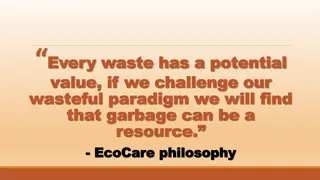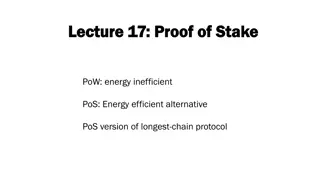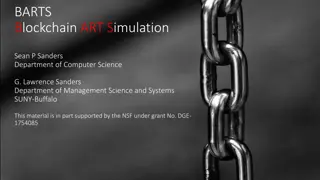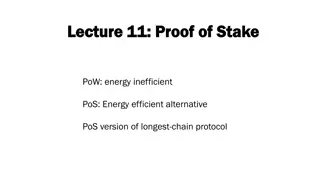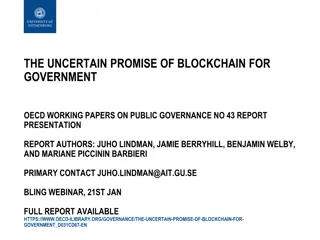Blockchain Without Waste: Proof-of-Stake
A study on Proof-of-Stake (PoS) as an alternative to Proof-of-Work (PoW) in blockchain technology. PoS aims to create a sustainable permissionless blockchain by selecting a stakeholder to authorize transactions without the heavy energy consumption of PoW. The paper provides a formal economic model of PoS and analyzes the conditions for achieving consensus.
Download Presentation

Please find below an Image/Link to download the presentation.
The content on the website is provided AS IS for your information and personal use only. It may not be sold, licensed, or shared on other websites without obtaining consent from the author.If you encounter any issues during the download, it is possible that the publisher has removed the file from their server.
You are allowed to download the files provided on this website for personal or commercial use, subject to the condition that they are used lawfully. All files are the property of their respective owners.
The content on the website is provided AS IS for your information and personal use only. It may not be sold, licensed, or shared on other websites without obtaining consent from the author.
E N D
Presentation Transcript
Blockchain Without Waste: Proof-of-Stake Fahad Saleh , New York University, Stern Present By : Lexing Fang
Abstract A blockchain constitutes a distributed ledger that records transactions across a network of agents. Blockchain s value proposition requires that agents eventually agree on the ledger s contents since payments possess risk otherwise. Restricted blockchains ensure this consensus by appointing a central authority to dictate payment validity. Permissionless blockchains (e.g. Bitcoin, Ethereum), however, admit no central authority and therefore face an issue of inducing consensus endogenously. Nakamoto (2008) provided a temporary solution to the problem by invoking an economic mechanism known as Proof-of-Work (PoW). PoW, however, lacks sustainability, so, in recent years, a variety of alternatives have been proposed. This paper studies the most famous such alternative, Proof-of-Stake (PoS).
Background Background Restricted blockchain: A blockchain constitutes a distributed ledger that records transactions across a network of agents. Such a communal ledger possesses value only if agents agree on the ledger s content. Consensus across agents may be achieved by appointing a central authority to dictate payment validity. Such a protocol describes a restricted blockchain. Unrestricted blockchain: Blockchain s potential to improve financial market efficiency hinges upon the viability of permissionless (a.k.a. unrestricted) blockchains; A permissionless blockchain s lack of a central authority renders the attainment of consensus a non-trivial issue.
Proof-of-Work (PoW) PoW requires agents to compete to update the blockchain. The competition consists of solving a trivial puzzle so that success probabilities depend on only raw computational power.
Proof-of-Stake (PoS) In hopes of creating a sustainable permissionless blockchain (i.e. one that does not expend an exorbitant amount of energy), the blockchain community has bandied about several alternatives to PoW. The most frequently discussed alternative is a mechanism known as Proof-of-Stake (PoS). PoS replaces PoW s competition by offering a randomly selected stakeholder the authority to update the blockchain; PoS thus omits any incentive for agents to engage in a computational arms race. Developers, however, remain reluctant to employ PoS because they fear that PoS fails to induce consensus. PoS, like PoW, offers an agent an explicit monetary reward to update the blockchain, but PoS, unlike PoW, imposes no explicit cost upon agents to gain the authority to update the blockchain.
Papers contribution: 1. Provide a formal economic model of PoS -- subvert the Nothing-at-Stake problem 2. Demonstrates general conditions under which PoS leads to consensus.
Nothing-at-Stake Figure depicts the Nothing-at-Stake problem. One may view the act of appending to a branch of the blockchain as voting for that particular branch. The argument proceeds by asserting that appending blocks to all branches possible constitutes a weakly dominant strategy because all block rewards have non-negative value and agents obtain the right to append to the blockchain without expense.
Not Nothing-at-Stake The Nothing-at-Stake problem alleges that players face no cost by deferring consensus. However, within a PoS protocol, all players with the ability to delay consensus own some coins, and delaying consensus reduces the value of those coins. Two particular strategies: (1) Longest Chain Rule (hereafter referenced as the LCR), corresponds to a player appending only to the longest branch whenever feasible with the longest chain being defined as branch 1 whenever both branches possess the same length. (1) Nothing-at-Stake strategy (hereafter referenced as the NSS), corresponds to a player appending a block whenever given the option in line with the Nothing-at-Stake problem.
Proposition 4.3 avers that coin value obtains a maximum if all players follow LCR. As the blockchain achieves consensus at the earliest possible time when all players follow LCR, coin prices achieve a maximum in this case. Proposition 4.3 also states that following NSS instead of LCR when all other players follow LCR strictly reduces coin value. This finding undermines the Nothing-at-Stake problem as it establishes that following NSS imposes a cost upon stakeholders.
Equilibrium Analysis This sub-section demonstrates that PoS achieves consensus under general conditions. -- show existence of an equilibrium in which PoS achieves consensus as soon as possible -- show that all equilibria obtain consensus eventually. If a player appends to the blockchain, she receives a block reward. This block reward possesses non- negative value, but appending to the blockchain may defer consensus and thus decrease coin value. A myopic player with no coins always appends to the blockchain when given the option if the block reward takes a positive value. Alternatively, a player with a large stake opts not to append to the blockchain when doing so defers consensus. Thus, an equilibrium in which all players follow the LCR exists if each player holds a sufficient stake.
Proposition 4.4 provides guidance to developers regarding designing a viable PoS blockchain. This proposition indicates that developers should restrict players with small stakes from appending to the blockchain. Having stake impels players to behave well. Moreover, the eligibility threshold for stake that ensures the existence of a symmetric LCR equilibrium depends upon the block reward level because a player must weigh her block reward against her pre- existing stake when deciding whether to append to the shorter branch. Corollary 4.5 highlights a trivial but important insight: a permissionless blockchain need not possess a block reward. This result arises because a player incurs a cost for delaying consensus but receives no off-setting reward for appending to the blockchain s shorter branch. If a player refuses to append to the blockchain s longer branch when all other players play LCR then she delays consensus and thereby undermines her own wealth. If a player appends to the blockchain s shorter branch when all other players play LCR then she also undermines her own wealth by delaying consensus, but she receives no block reward to counteract her loss.
Conclusion This paper provides a formal economic analysis of PoS and it demonstrates that PoS achieves consensus under general conditions. Therefore, developers may implement a viable permissionless blockchain without prohibitive energy consumption.
My Opinion My Opinion
Thank you! Thank you!











